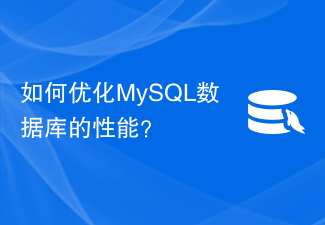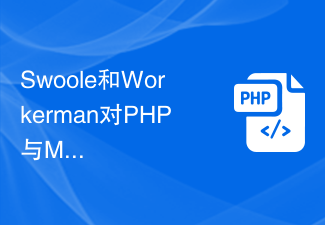 Web Front-end
Web Front-end HTML Tutorial
HTML Tutorial Improve system response speed and optimize secondary cache update strategy
Improve system response speed and optimize secondary cache update strategy
With the development of Internet technology, more and more systems and applications need to process large amounts of data. In order to improve the system's response speed and reduce data access time, developers often use caching mechanisms to optimize system performance. Among them, the second-level cache is a commonly used caching mechanism. It is located between the application and the database and is used to cache data obtained from accessing the database. This article aims to discuss how to optimize the update mechanism of the second-level cache to improve the response speed of the system.
In order to understand the update mechanism of the second-level cache, you first need to understand the basic workflow of the second-level cache. When an application needs to access data in the database, it first checks whether the required data exists in the cache. If it exists, the application will get the data directly from the cache, avoiding access to the database; if it does not exist, the application will read the data from the database and store it in the cache for next time use. When the data in the database changes, the cache needs to be updated to ensure that the data in the cache is consistent with the data in the database.
The update mechanism of the second-level cache usually has two methods: time-based update and event-based update.
The time-based update mechanism refers to setting an expiration time while caching data. When the data exceeds this expiration time, the cache will be marked as expired and the latest data will be retrieved from the database on the next access. This update mechanism is simple and easy to implement, and is suitable for scenarios where data changes are infrequent. However, when data changes frequently, excessive data updates may cause delays in cache updates, thus affecting the system's response speed.
The event-based update mechanism refers to notifying cache updates through the event triggering mechanism when the data in the database changes. When the data in the database changes, the corresponding event will be triggered to notify the cache of updates. This update mechanism can update the data in the cache in real time to ensure data consistency. However, a real-time update mechanism increases system overhead and may cause performance issues in high concurrency situations.
In order to improve the response speed of the system, we can take the following optimization measures:
- Combine time and events: cache batch updates within an appropriate time interval. For some scenarios where data changes frequently, you can set a minimum time interval based on business needs, and update the cache within this time interval. In addition, the cache can be updated in real time through the event triggering mechanism. This not only takes into account the real-time nature of the data, but also reduces the impact on system performance.
- Use incremental updates: When the data in the database changes, you can update only the changed data instead of updating the entire cache. This can reduce the amount of data transmission between the database and the cache and improve the response speed of the system. At the same time, incremental updates can be performed asynchronously to avoid blocking the running of the application.
- Set the cache expiration time reasonably: According to the business characteristics and data change frequency, set the cache expiration time reasonably. For data that changes infrequently, you can set a longer expiration time to reduce the number of cache updates; for data that changes frequently, you can set a shorter expiration time to ensure the real-time nature of the data.
- Use distributed cache: If the system has multiple nodes or multiple application servers, consider using distributed cache. Distributed cache can distribute cached data to different nodes, improve the concurrent access capability of the cache, and further improve the response speed of the system.
To sum up, by optimizing the update mechanism of the second-level cache, the response speed of the system can be improved. Properly choose the cache update mechanism, update based on time and events, use incremental updates and reasonably set the cache expiration time, use distributed cache and other measures, which can effectively reduce the number of accesses to the database and reduce the cost of data transmission. Thereby improving system performance and user experience.
The above is the detailed content of Improve system response speed and optimize secondary cache update strategy. For more information, please follow other related articles on the PHP Chinese website!
 Laravel开发建议:如何优化图片处理与缓存Nov 22, 2023 am 09:17 AM
Laravel开发建议:如何优化图片处理与缓存Nov 22, 2023 am 09:17 AMLaravel开发建议:如何优化图片处理与缓存引言在现代web开发中,图片处理与缓存是一个常见且重要的问题。优化图片处理和缓存策略不仅可以提高网站的性能和用户体验,还能减少带宽消耗和服务器负载。本文将探讨如何在Laravel开发中优化图片处理与缓存的方法与建议。1.选择合适的图片格式选择合适的图片格式是优化图片处理的首要步骤。常见的图片格式有JPEG、PNG
 如何优化Discuz论坛性能?Mar 12, 2024 pm 06:48 PM
如何优化Discuz论坛性能?Mar 12, 2024 pm 06:48 PM如何优化Discuz论坛性能?引言:Discuz是一个常用的论坛系统,但在使用过程中可能会遇到性能瓶颈问题。为了提升Discuz论坛的性能,我们可以从多个方面进行优化,包括数据库优化、缓存设置、代码调整等方面。下面将介绍如何通过具体的操作和代码示例来优化Discuz论坛的性能。一、数据库优化:索引优化:为频繁使用的查询字段建立索引,可以大幅提升查询速度。例如
 在PHP应用中使用Redis缓存技术优化对象或数组的存储Jun 20, 2023 am 09:21 AM
在PHP应用中使用Redis缓存技术优化对象或数组的存储Jun 20, 2023 am 09:21 AM随着web应用程序的不断发展,对象或数组的存储和检索变得越来越常见。然而,当应用程序处理大量数据时,这种存储方式可能会变得缓慢和不可靠。为了优化这种情况,PHP应用程序可以使用Redis缓存技术来提高数据存取速度和性能。Redis是一个开源的内存数据结构存储系统,被广泛用于缓存,处理消息队列和实现实时分析等任务。Redis的出色性能和可伸缩性,使其成为许多P
 如何优化MySQL数据库的性能?Sep 11, 2023 pm 06:10 PM
如何优化MySQL数据库的性能?Sep 11, 2023 pm 06:10 PM如何优化MySQL数据库的性能?在现代信息时代,数据已经成为企业和组织的重要资产。作为最常用的关系型数据库管理系统之一,MySQL在各行各业都广泛地应用着。然而,随着数据量的增长和负载的增加,MySQL数据库的性能问题也逐渐凸显。为了提高系统的稳定性和响应速度,优化MySQL数据库的性能是至关重要的。本文将介绍一些常见的MySQL数据库性能优化方法,帮助读者
 Vue3与Vue2的区别:更快的响应速度Jul 09, 2023 pm 01:22 PM
Vue3与Vue2的区别:更快的响应速度Jul 09, 2023 pm 01:22 PMVue3与Vue2的区别:更快的响应速度Vue是一个流行的JavaScript框架,用于构建用户界面。它的流畅性和响应速度对于开发者和用户来说非常重要。在Vue2的基础上,Vue3进行了一些改进,从而提供了更快的响应速度。本文将探讨Vue3相对于Vue2在性能方面的改进,并提供一些代码示例来说明这些改进。响应式系统的重写:Vue3对其响应式系统进行了重写,采
 如何在Laravel中使用中间件进行缓存优化Nov 02, 2023 pm 01:31 PM
如何在Laravel中使用中间件进行缓存优化Nov 02, 2023 pm 01:31 PM如何在Laravel中使用中间件进行缓存优化缓存是一种优化技术,可以显著提高应用程序的性能和响应速度。在Laravel框架中,我们可以使用中间件来实现缓存的优化。本文将详细介绍如何在Laravel中使用中间件进行缓存优化,并提供具体的代码示例。安装和配置中间件首先,我们需要安装Laravel的缓存包。可以使用以下命令进行安装:composerrequire
 golang函数缓存性能优化技巧分享May 01, 2024 pm 01:24 PM
golang函数缓存性能优化技巧分享May 01, 2024 pm 01:24 PM函数缓存是一种性能优化技术,可存储函数调用结果以进行重复使用,避免重复计算。在Go中,可以通过使用map或sync.Map实现函数缓存,并根据特定场景采用不同的缓存策略。例如,简单的缓存策略将所有函数参数用作缓存键,而细化的缓存策略仅缓存部分结果以节省空间。此外,并发安全缓存和失效策略可以进一步优化缓存性能。通过应用这些技巧,可以明显提高函数调用的执行效率。
 Swoole和Workerman对PHP与MySQL的数据本地缓存和远程缓存的优化方法Oct 15, 2023 pm 12:27 PM
Swoole和Workerman对PHP与MySQL的数据本地缓存和远程缓存的优化方法Oct 15, 2023 pm 12:27 PMSwoole和Workerman对PHP与MySQL的数据本地缓存和远程缓存的优化方法,需要具体代码示例随着互联网的发展,PHP和MySQL作为开发Web应用的主要工具,其性能和效率问题一直是开发者关注的焦点。为了提高性能,减轻数据库压力,开发者通常会采取数据缓存的方式来优化应用程序。本文将介绍使用Swoole和Workerman两个常用的PHP扩展来进行数


Hot AI Tools

Undresser.AI Undress
AI-powered app for creating realistic nude photos

AI Clothes Remover
Online AI tool for removing clothes from photos.

Undress AI Tool
Undress images for free

Clothoff.io
AI clothes remover

AI Hentai Generator
Generate AI Hentai for free.

Hot Article

Hot Tools

Atom editor mac version download
The most popular open source editor

DVWA
Damn Vulnerable Web App (DVWA) is a PHP/MySQL web application that is very vulnerable. Its main goals are to be an aid for security professionals to test their skills and tools in a legal environment, to help web developers better understand the process of securing web applications, and to help teachers/students teach/learn in a classroom environment Web application security. The goal of DVWA is to practice some of the most common web vulnerabilities through a simple and straightforward interface, with varying degrees of difficulty. Please note that this software

VSCode Windows 64-bit Download
A free and powerful IDE editor launched by Microsoft

SecLists
SecLists is the ultimate security tester's companion. It is a collection of various types of lists that are frequently used during security assessments, all in one place. SecLists helps make security testing more efficient and productive by conveniently providing all the lists a security tester might need. List types include usernames, passwords, URLs, fuzzing payloads, sensitive data patterns, web shells, and more. The tester can simply pull this repository onto a new test machine and he will have access to every type of list he needs.

SAP NetWeaver Server Adapter for Eclipse
Integrate Eclipse with SAP NetWeaver application server.




